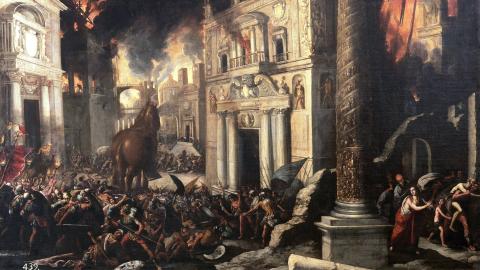
It is 250 years since Lieutenant James Cook, a relative newcomer to the naval world, set sail from Whitby on the HMS Endeavour, with his 90-strong crew, in search of Venus and the “southern continent”. It was the first of three expeditions Cook made to the South Pacific, the last of which would end in his murder. The man who would soon be known as “Captain Cook” was about to change the world.
The Man, the Myth… the God
Captain Cook is an icon within our seafaring heritage. The anniversary of his first expedition has been celebrated with a series of events across the UK, Australia and New Zealand. A celebrity of his time and a legend after his death, his journals – published during his lifetime – captivated the public with tales of perilous travels into realms and cultures beyond their wildest imaginings. Without Captain Cook, there might be no Captain Kirk.
He discovered new lands and revolutionised perceptions of world geography; plotting out huge sections of the Pacific on the map, including New Zealand and Australia. For centuries, experts have held that he never lost a single crew member to scurvy – the scourge of eighteenth-century sailors. Some have even credited him with curing the disease! Cook was deified by his most famous biographer, Beaglehole, who rhapsodised about his strategic genius, daring and unbending humanity. And when he landed in Hawaii, during his final expedition, natives watching him emerge from the water reportedly believed he was a literal god (Lono, god of fertility to be precise!).
The Start of Globalisation
Voyages like those of Cook and Columbus were the start of globalisation. Like everything that has followed, there was a darker side to these expeditions, which grew pronounced in the unravelling of Cook’s last, ill-fated trip. His crew entered each new stop off like a stag party on tour, spreading venereal diseases left, right and centre. While Cook disapproved of such behaviour, he also exploited his hosts, with relentless demands for provisions and resources.
Cook’s discovery of these unspoilt lands brought further envoys and disease, from syphilis to leprosy. Floods of incoming missionaries set to work imposing Christianity on natives, assaulting their ancient belief and custom. The fur trade gave way to tourism, to the harvesting of pineapples, coffee and sugar cane. While much of this was not directly his fault, Captain Cook’s arrival on these virgin soils set an unstoppable chain in motion. With rotting fruit thrown at his statue, adorned with graffiti like 'Whitey go home', standing at the spot where he died, it is safe to say not all Hawaiians are grateful they were discovered. American writer, Mark Twain, described Cook’s final destruction as ‘justifiable homicide’.
Crime and Punishment
Cook had a violent temper. Though Beaglehole asserted ‘the Captain’s temper was rather short, though his anger was short-lived too’, his heivas
(named after the Polynesian dance) reached fever pitch during the final voyage. Alongside brutal floggings of his disobedient crew, his retribution of indigenous people caught stealing from the ship, ranged from six dozen lashes to cutting off ears. When a goat was stolen, during a stopover at Tahiti, Cook ordered a two-day assault of arson and destruction. The goat was returned unharmed and the ship sailed away, leaving the islanders’ homes and community in tatters.
Cook’s final, fateful temper tantrum led to his death, when he responded to yet more theft, by ordering his crew to open fire on Hawaiians, before he tried to take their king hostage, and was killed in the struggle that ensued. We may never know if they still saw him as a god when they killed him – if they ever really had – but some people believe they ate him.
A controversial contemporary painting of Cook’s last stand, debunked previous tales of him calling to an end to the violence when it was discovered in 2004. Based on an eyewitness account, John Cleveley’s watercolour shows him fighting for his life with a musket against the angry mob. More of a man than a Christ-like martyr.
Celebrity Culture
Following the success of his first two voyages, Cook’s new-found celebrity may have gone to his head, as it is said by some; he spent crucial time working on his journals and sitting for his portrait when he should have been preparing for the third expedition. After setting sail, Cook’s shipmaster, William Bligh (who would, himself, go on to be a celebrated navigator and hydrographer) was appalled by moments of what he saw as outright sloppiness and recklessness. As the disastrous journey progressed, this lax approach cost lives. And when miscalculations forced them back to Hawaii, these included his own.
All About Scurvy
It is said that few of Cook’s crew ever suffered from scurvy, and none died from of it – setting a dramatic precedent for the time. The thing about scurvy, though, is it tended to cloud people’s judgement – creating a Catch-22 situation. As you could not trust people with scurvy to accurately judge whether they had scurvy, it was notoriously difficult to assess who did and didn’t have the disease, at the end of a sea voyage.
Cook, it was said, held religious faith in eating fresh food, wherever it came from. Known for his ‘coarse palate’, he appalled his crew, on the final voyage, by eating slaughtered walrus meat, and imploring them to follow suit. One theory has it, that Captain Cook had developed a disease similar to scurvy, due to his poor diet, which caused the erratic behaviour, which led to his downfall.
Much like the eulogised accounts of his seafaring career, some may find this revisionist irony a little too neat.
A God or a Devil?
Like many historical figures, we know very little about Cook, compared to the myth, legend and opinion which have formed around him over time. Ultimately, he was a man doing a job, which, for the most part, he did exceptionally well.
This summer, while children across Britain and the Antipodes hear, once again, about his valour and heroism, some Hawaiians may yet remember the ‘devil’ of Western imperialism, and all that followed




















